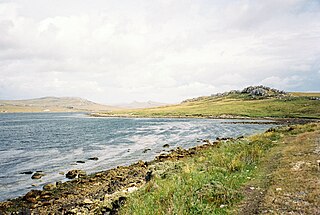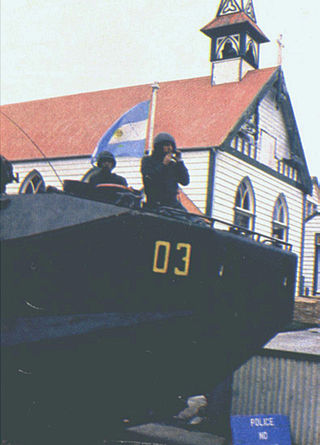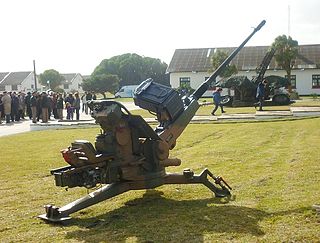
The Falklands War was a ten-week undeclared war between Argentina and the United Kingdom in 1982 over two British dependent territories in the South Atlantic: the Falkland Islands and its territorial dependency, South Georgia and the South Sandwich Islands. The conflict began on 2 April 1982, when Argentina invaded and occupied the Falkland Islands, followed by the invasion of South Georgia the next day. On 5 April, the British government dispatched a naval task force to engage the Argentine Navy and Air Force before making an amphibious assault on the islands. The conflict lasted 74 days and ended with an Argentine surrender on 14 June, returning the islands to British control. In total, 649 Argentine military personnel, 255 British military personnel, and three Falkland Islanders were killed during the hostilities.

The Battle of Mount Harriet was an engagement of the Falklands War, which took place on the night of 11/12 June 1982 between British and Argentine forces. It was one of three battles in a Brigade-size operation all on the same night, the other two being the Battle of Mount Longdon and the Battle of Two Sisters.
The Battle of Two Sisters was an engagement of the Falklands War during the British advance towards the capital, Port Stanley. It took place from 11 to 12 June 1982 and was one of three battles in a Brigade-size operation all on the same night, the other two being the Battle of Mount Longdon and the Battle of Mount Harriet. It was fought mainly between an assaulting British force consisting of Royal Marines of 45 Commando and an Argentine Company drawn from 4th Infantry Regiment.

The Battle of Mount Tumbledown was an engagement during the Falklands War. The engagement was an attack by the British Army and the Royal Marines on the heights overlooking Stanley, the Falkland Islands capital. Mount Tumbledown, Mount William and Sapper Hill lie west of the capital. Due to their proximity to the capital, they were of strategic importance during the 1982 War. They were held by the Argentine 5th Naval Infantry Battalion, a reinforced, cold weather trained and equipped Marine battalion.

Darwin is a settlement in Lafonia on East Falkland, Falkland Islands, lying on Choiseul Sound, on the east side of the island's central isthmus, 2.5 miles (4.0 km) north of Goose Green. It was known occasionally as Port Darwin.

The Invasion of the Falkland Islands, code-named Operation Rosario, was a military operation launched by Argentine forces on 2 April 1982, to capture the Falkland Islands, and served as a catalyst for the subsequent Falklands War. The Argentines mounted amphibious landings and the invasion ended with the surrender of Falkland Government House.
This is a list of the ground forces from Argentina that took part in the Falklands War. For a list of ground forces from the United Kingdom, see British ground forces in the Falklands War.
The 602 Commando Company is a special operations unit of the Argentine Army.

Fox Bay is the second largest settlement on West Falkland in the Falkland Islands. It is located on a bay of the same name, and is on the south east coast of the island. It is often divided into Fox Bay East ("FBE") and Fox Bay West ("FBW") making it two settlements: combined, these make the largest settlement on West Falkland, but if separated, Port Howard is the largest. Fox Bay takes its name, like the Warrah River, from the Falkland fox, an animal locally called the warrah and now extinct.
801 Naval Air Squadron (NAS) was a Fleet Air Arm squadron of the Royal Navy formed in 1933 which fought in World War II, the Korean War and the Falklands War.

Sapper Hill (453 ft) is on East Falkland, located just south of Stanley, the Falklands Islands capital. It is named after a troop of sappers who were once billeted at Moody Brook barracks.
Captain Gavin John Hamilton, MC was a British Army infantry soldier. He was the Officer Commanding 19 (Mountain) Troop, D Squadron, 22 Special Air Service during the Falklands War when he was killed in action behind enemy lines on West Falkland.
On 10 June 1982, in the closing days of the Falklands War, Many Branch Point, a ridge near Port Howard in West Falkland, was the site of a minor skirmish between the Argentine and British Armed Forces. The engagement ended with the death of the SAS patrol commander, Captain Gavin Hamilton. The action was the only ground engagement of the British and Argentine forces on West Falkland during the conflict.

The 601st Anti-Aircraft Artillery Group, historically known as GADA 601 is the main anti-aircraft artillery unit of the Argentine Army. Its headquarters are just north of Mar del Plata. The unit's name was changed to GAA 601 Teniente General Pablo Ricchieri in 1999. The group played a key role during the 1982 Falklands War. The GAA 601 compound is the main air defence training center in Argentina.

Duplicate: List of Falkland Islands–related topics

The occupation of the Falkland Islands and South Georgia and the South Sandwich Islands was the short-lived Argentine occupation of a group of British islands in the South Atlantic whose sovereignty has long been disputed by Argentina. Until their invasion on 2 April 1982 by the Argentine military junta, they had been governed by the United Kingdom since it re-established control over them in 1833.
The Battle of Mount Kent was a series of engagements during the Falklands War, primarily between British and Argentine special forces.

Blue Beach Military Cemetery at San Carlos is a British war cemetery in the Falkland Islands holding the remains of 14 of the 255 British casualties killed during the Falklands War in 1982, and one other killed in early 1984. It is situated close to where 3 Commando Brigade had its initial headquarters after landing on 21 May 1982.

The 601 Commando Company is a special operations unit of the Argentine Army.














